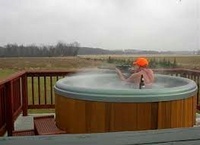Wadcutter bullet design
3 posters
Page 1 of 1
 Wadcutter bullet design
Wadcutter bullet design
Something that occurred to me while loading... on a full wadcutter bullet - what's the purpose of the dimple and/or groove on the front? Other than possibly informing the loader which end is supposed to leave the barrel first. I'm trying, and failing, to see any aerodynamic purpose for them. They are present, in one way or another, on Lapua, Speer and Missouri bullets that I've loaded for 32 SWL and also the Zero bullets for 38 SP.
Anyone got any insights?
Anyone got any insights?
straybrit- Posts : 372
Join date : 2012-09-05
 Re: Wadcutter bullet design
Re: Wadcutter bullet design
Found this on a casting bullets forum- FWIW
"That cute little vestigial nose left on these Type II wadcutters is intended to provide additional aerodynamic stability by breaking up the air-flow and starting the slipstream. Since these are virtually always subsonic bullets (not only sub-sonic, but below 0.85 Mach, or roughly 900 fps), the airstream is roughly conformal to the bullet's profile, with turbulent flow in the boundary layer at these velocities. There is no super-sonic "bow-wave". A flat face with a sharp shoulder (e.g. Ideal 358348) can induce substantial turbulence just aft of the shoulder. This is because the slipstream is unable to flow smoothly around a sharp 90 degree corner, so there are turbulent "eddies" formed just aft of this shoulder, which can destabilize the spinning wadcutter and lead to tumbling. By putting a small nose just forward of the flat face, the airflow is more gradually redirected as a result of the eddies formed along the sides of the nose, resulting in somewhat greater stability in flight, and therefore longer accurate range before the wadcutter starts to tumble."
"That cute little vestigial nose left on these Type II wadcutters is intended to provide additional aerodynamic stability by breaking up the air-flow and starting the slipstream. Since these are virtually always subsonic bullets (not only sub-sonic, but below 0.85 Mach, or roughly 900 fps), the airstream is roughly conformal to the bullet's profile, with turbulent flow in the boundary layer at these velocities. There is no super-sonic "bow-wave". A flat face with a sharp shoulder (e.g. Ideal 358348) can induce substantial turbulence just aft of the shoulder. This is because the slipstream is unable to flow smoothly around a sharp 90 degree corner, so there are turbulent "eddies" formed just aft of this shoulder, which can destabilize the spinning wadcutter and lead to tumbling. By putting a small nose just forward of the flat face, the airflow is more gradually redirected as a result of the eddies formed along the sides of the nose, resulting in somewhat greater stability in flight, and therefore longer accurate range before the wadcutter starts to tumble."

jwax- Posts : 554
Join date : 2011-06-10
Location : Western ny
Schaumannk and troystaten like this post
 Re: Wadcutter bullet design
Re: Wadcutter bullet design
Huh - well, there you go. Thanks for that. Any day where you learn something interesting can't be a bad day.
straybrit- Posts : 372
Join date : 2012-09-05
 Re: Wadcutter bullet design
Re: Wadcutter bullet design
Interesting. How then do hard cast DEWC shoot well at or above 900 fps?jwax wrote:Found this on a casting bullets forum- FWIW
"That cute little vestigial nose left on these Type II wadcutters is intended to provide additional aerodynamic stability by breaking up the air-flow and starting the slipstream. Since these are virtually always subsonic bullets (not only sub-sonic, but below 0.85 Mach, or roughly 900 fps), the airstream is roughly conformal to the bullet's profile, with turbulent flow in the boundary layer at these velocities. There is no super-sonic "bow-wave". A flat face with a sharp shoulder (e.g. Ideal 358348) can induce substantial turbulence just aft of the shoulder. This is because the slipstream is unable to flow smoothly around a sharp 90 degree corner, so there are turbulent "eddies" formed just aft of this shoulder, which can destabilize the spinning wadcutter and lead to tumbling. By putting a small nose just forward of the flat face, the airflow is more gradually redirected as a result of the eddies formed along the sides of the nose, resulting in somewhat greater stability in flight, and therefore longer accurate range before the wadcutter starts to tumble."

Allgoodhits- Posts : 890
Join date : 2017-09-17
Location : Southport, NC
 Similar topics
Similar topics» .32 wadcutter bullet source question.
» Winchester wadcutter 38 bulk component bullet
» Shooting Box Design
» Design a 41 rear end for me
» New MCP Beretta 92 design
» Winchester wadcutter 38 bulk component bullet
» Shooting Box Design
» Design a 41 rear end for me
» New MCP Beretta 92 design
Page 1 of 1
Permissions in this forum:
You cannot reply to topics in this forum|
|
|
